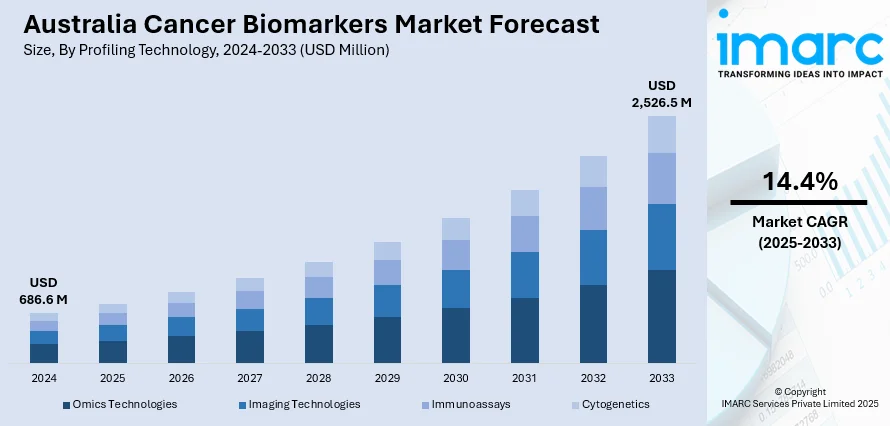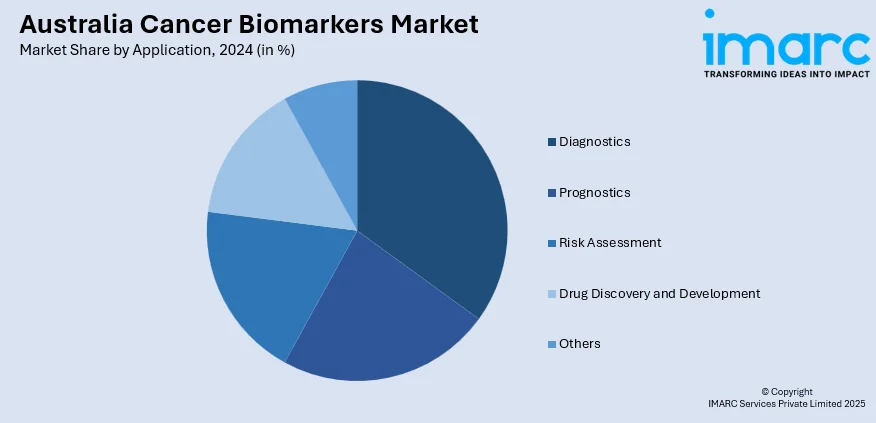
Australia Cancer Biomarkers Market Size, Share, Trends and Forecast by Profiling Technology, Biomolecule, Cancer Type, Application, End User, and Region, 2025-2033
Australia Cancer Biomarkers Market Overview:
The Australia cancer biomarkers market size reached USD 686.6 Million in 2024. Looking forward, IMARC Group expects the market to reach USD 2,526.5 Million by 2033, exhibiting a growth rate (CAGR) of 14.4% during 2025-2033. The market is experiencing steady growth, driven by advancements in early cancer detection and personalized treatment approaches. Increasing research activities, rising awareness among healthcare providers, and expanding applications of biomarkers across various cancer types are supporting market development. Strategic collaborations between research institutes and biotech firms further enhance innovation. Favorable healthcare policies also contribute to a positive outlook for the sector, boosting Australia Cancer Biomarkers share.
|
Report Attribute
|
Key Statistics
|
|---|---|
|
Base Year
|
2024
|
|
Forecast Years
|
2025-2033
|
|
Historical Years
|
2019-2024
|
| Market Size in 2024 | USD 686.6 Million |
| Market Forecast in 2033 | USD 2,526.5 Million |
| Market Growth Rate 2025-2033 | 14.4% |
Australia Cancer Biomarkers Market Trends:
Growing Adoption of Precision Medicine
The increasing focus on individualized cancer therapy in Australia is boosting demand for cancer biomarkers. Precision medicine adjusts treatment according to the unique genetic makeup and biomarker expression of each patient, allowing more specific therapies and better outcomes. Government and industry investment in genomic research, coupled with greater availability of high-throughput sequencing technology, has stepped up biomarker discovery. Hospitals and cancer centers are increasingly incorporating biomarker testing to inform treatment choices for tumors such as breast, lung, and colorectal. Regulatory approaches facilitating companion diagnostics are also propelling the Australia cancer biomarkers market growth. With efficacy and fewer side effects becoming more of a concern to patients and doctors alike, the market is shifting away from the one-size-fits-all philosophy toward biomarker-directed treatments that maximize treatment protocols and increase survivorship.

To get more information on this market, Request Sample
Integration of Artificial Intelligence in Biomarker Discovery
Artificial Intelligence (AI) is changing Australia's cancer biomarker scene at a quickening rate, and this trend is firmly backed by heavy government investment. In 2024, the MRFF provided $27 million to eight genomic research projects, including $8 million specifically earmarked for a consortium to create AI-driven tools for cancer diagnosis and treatment. This investment is part of the general trend to apply machine learning algorithms to process complex genomic and proteomic data to identify new biomarkers more rapidly and accurately. AI also supports diagnostic imaging and pathology through correlations of visual and molecular information to increase accuracy and personalize therapy. Australian biotech companies, universities, and foreign research institutes are collaborating to drive innovation. As AI technologies advance, they will automate biomarker discovery, cut diagnostic development time, and improve oncology care outcomes.
Expansion of Liquid Biopsy Technologies
Australia is witnessing fast growth in the use of liquid biopsy as a non-invasive technique for cancer detection and monitoring using biomarkers like circulating tumor DNA (ctDNA). It enables early diagnosis, real-time monitoring of treatment response, and detection of minimal residual disease without invasive tissue biopsies. Liquid biopsies are increasingly being adopted because they are convenient, safe, and have the potential to be used in screening high-risk populations. Australian research institutions and biotech firms are investing in the development of sophisticated liquid biopsy assays, particularly for difficult-to-biopsy tumors. Regulatory approval and growing clinical trials further confirm their application. As the technology advances, it is set to greatly increase the cancer biomarker market in diagnostics and treatment planning.
Australia Cancer Biomarkers Market Segmentation:
IMARC Group provides an analysis of the key trends in each segment of the market, along with forecasts at the country and regional for 2025-2033. Our report has categorized the market based on profiling technology, biomolecule, cancer type, application, and end user.
Profiling Technology Insights:
- Omics Technologies
- Imaging Technologies
- Immunoassays
- Cytogenetics
The report has provided a detailed breakup and analysis of the market based on the profiling technology. This includes omics technologies, imaging technologies, immunoassays, and cytogenetics.
Biomolecule Insights:
- Genetic Biomarkers
- Protein Biomarkers
- Glyco-Biomarkers
A detailed breakup and analysis of the market based on the biomolecule have also been provided in the report. This includes genetic biomarkers, protein biomarkers, and glyco-biomarkers.
Cancer Type Insights:
- Breast Cancer
- Lung Cancer
- Colorectal Cancer
- Prostate Cancer
- Stomach
- Others
The report has provided a detailed breakup and analysis of the market based on the cancer type. This includes breast cancer, lung cancer, colorectal cancer, prostate cancer, stomach, and others.
Application Insights:

- Diagnostics
- Prognostics
- Risk Assessment
- Drug Discovery and Development
- Others
A detailed breakup and analysis of the market based on the application have also been provided in the report. This includes diagnostics, prognostics, risk assessment, drug discovery and development, and others.
End User Insights:
- Hospitals
- Academic and Research Institutions
- Ambulatory Surgical Centers
- Diagnostic Laboratories
- Others
The report has provided a detailed breakup and analysis of the market based on the end user. This includes hospitals, academic and research institutions, ambulatory surgical centers, diagnostic laboratories, and others.
Regional Insights:
- Australia Capital Territory & New South Wales
- Victoria & Tasmania
- Queensland
- Northern Territory & Southern Australia
- Western Australia
The report has also provided a comprehensive analysis of all the major regional markets, which include Australia Capital Territory & New South Wales, Victoria & Tasmania, Queensland, Northern Territory & Southern Australia, and Western Australia.
Competitive Landscape:
The market research report has also provided a comprehensive analysis of the competitive landscape. Competitive analysis such as market structure, key player positioning, top winning strategies, competitive dashboard, and company evaluation quadrant has been covered in the report. Also, detailed profiles of all major companies have been provided.
Australia Cancer Biomarkers Market News:
- In April 2025, The Institute of Cancer Research (ICR), London, and QBiotics partnered to study tigilanol tiglate, a potential cancer drug derived from Australia’s blushwood tree. Currently in clinical trials for head and neck cancers, the drug is injected directly into tumors and shows promise in destroying cancer cells, disrupting blood supply, and activating immune responses. Already approved for veterinary use, it is now being explored for human cancer treatment.
Australia Cancer Biomarkers Market Report Coverage:
| Report Features | Details |
|---|---|
| Base Year of the Analysis | 2024 |
| Historical Period | 2019-2024 |
| Forecast Period | 2025-2033 |
| Units | Million USD |
| Scope of the Report |
Exploration of Historical Trends and Market Outlook, Industry Catalysts and Challenges, Segment-Wise Historical and Future Market Assessment:
|
| Profiling Technologies Covered | Omics Technologies, Imaging Technologies, Immunoassays, Cytogenetics |
| Biomolecules Covered | Genetic Biomarkers, Protein Biomarkers, Glyco-Biomarkers |
| Cancer Types Covered | Breast Cancer, Lung Cancer, Colorectal Cancer, Prostate Cancer, Stomach, Others |
| Applications Covered | Diagnostics, Prognostics, Risk Assessment, Drug Discovery and Development, Others |
| End Users Covered | Hospitals, Academic and Research Institutions, Ambulatory Surgical Centers, Diagnostic Laboratories, Others |
| Regions Covered | Australia Capital Territory & New South Wales, Victoria & Tasmania, Queensland, Northern Territory & Southern Australia, Western Australia |
| Customization Scope | 10% Free Customization |
| Post-Sale Analyst Support | 10-12 Weeks |
| Delivery Format | PDF and Excel through Email (We can also provide the editable version of the report in PPT/Word format on special request) |
Key Questions Answered in This Report:
- How has the Australia cancer biomarkers market performed so far and how will it perform in the coming years?
- What is the breakup of the Australia cancer biomarkers market on the basis of profiling technology?
- What is the breakup of the Australia cancer biomarkers market on the basis of biomolecule?
- What is the breakup of the Australia cancer biomarkers market on the basis of cancer type?
- What is the breakup of the Australia cancer biomarkers market on the basis of application?
- What is the breakup of the Australia cancer biomarkers market on the basis of end user?
- What is the breakup of the Australia cancer biomarkers market on the basis of region?
- What are the various stages in the value chain of the Australia cancer biomarkers market?
- What are the key driving factors and challenges in the Australia cancer biomarkers?
- What is the structure of the Australia cancer biomarkers market and who are the key players?
- What is the degree of competition in the Australia cancer biomarkers market?
Key Benefits for Stakeholders:
- IMARC’s industry report offers a comprehensive quantitative analysis of various market segments, historical and current market trends, market forecasts, and dynamics of the Australia cancer biomarkers market from 2019-2033.
- The research report provides the latest information on the market drivers, challenges, and opportunities in the Australia cancer biomarkers market.
- Porter's five forces analysis assist stakeholders in assessing the impact of new entrants, competitive rivalry, supplier power, buyer power, and the threat of substitution. It helps stakeholders to analyze the level of competition within the Australia cancer biomarkers industry and its attractiveness.
- Competitive landscape allows stakeholders to understand their competitive environment and provides an insight into the current positions of key players in the market.
Need more help?
- Speak to our experienced analysts for insights on the current market scenarios.
- Include additional segments and countries to customize the report as per your requirement.
- Gain an unparalleled competitive advantage in your domain by understanding how to utilize the report and positively impacting your operations and revenue.
- For further assistance, please connect with our analysts.
 Request Customization
Request Customization
 Speak to an Analyst
Speak to an Analyst
 Request Brochure
Request Brochure
 Inquire Before Buying
Inquire Before Buying




.webp)




.webp)












